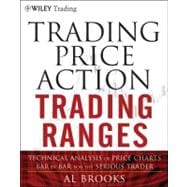
What is included with this book?
List of Terms Used in This Book xiii
Introduction 1
PART I Breakouts: Transitioning into a New Trend 35
CHAPTER 1 Example of How to Trade a Breakout 53
CHAPTER 2 Signs of Strength in a Breakout 61
CHAPTER 3 Initial Breakout 81
CHAPTER 4 Breakout Entries in Existing Strong Trends 91
CHAPTER 5 Failed Breakouts, Breakout Pullbacks, and Breakout Tests 99
CHAPTER 6 Gaps 119
PART II Magnets: Support and Resistance 139
CHAPTER 7 Measured Moves Based on the Size of the First Leg (the Spike) 153
CHAPTER 8 Measured Moves Based on Gaps and Trading Ranges 165
CHAPTER 9 Reversals Often End at Signal Bars from Prior Failed Reversals 175
CHAPTER 10 Other Magnets 179
PART III Pullbacks: Trends Converting to Trading Ranges 183
CHAPTER 11 First Pullback Sequence: Bar, Minor Trend Line, Moving Average, Moving Average Gap, Major Trend Line 205
CHAPTER 12 Double Top Bear Flags and Double Bottom Bull Flags 213
CHAPTER 13 Twenty Gap Bars 233
CHAPTER 14 First Moving Average Gap Bars 239
CHAPTER 15 Key Inflection Times of the Day That Set Up Breakouts and Reversals 245
CHAPTER 16 Counting the Legs of Trends and Trading Ranges 253
CHAPTER 17 Bar Counting: High and Low 1, 2, 3, and 4 Patterns and ABC Corrections 259
CHAPTER 18 Wedge and Other Three-Push Pullbacks 301
CHAPTER 19 Dueling Lines: Wedge Pullback to the Trend Line 313
CHAPTER 20 “Reversal” Patterns: Double Tops and Bottoms and Head and Shoulders Tops and Bottoms 319
PART IV Trading Ranges 327
CHAPTER 21 Example of How to Trade a Trading Range 367
CHAPTER 22 Tight Trading Ranges 377
CHAPTER 23 Triangles 411
PART V Orders and Trade Management 417
CHAPTER 24 Scalping, Swinging, Trading, and Investing 419
CHAPTER 25 Mathematics of Trading: Should I Take This Trade? Will I Make Money If I Take This Trade? 437
CHAPTER 26 Need Two Reasons to Take a Trade 481
CHAPTER 27 Entering on Stops 491
CHAPTER 28 Entering on Limits 493
CHAPTER 29 Protective and Trailing Stops 517
CHAPTER 30 Profit Taking and Profit Targets 535
CHAPTER 31 Scaling Into and Out of a Trade 543
CHAPTER 32 Getting Trapped In or Out of a Trade 567
About the Author 571
About the Website 573
Index 575
The New copy of this book will include any supplemental materials advertised. Please check the title of the book to determine if it should include any access cards, study guides, lab manuals, CDs, etc.
The Used, Rental and eBook copies of this book are not guaranteed to include any supplemental materials. Typically, only the book itself is included. This is true even if the title states it includes any access cards, study guides, lab manuals, CDs, etc.